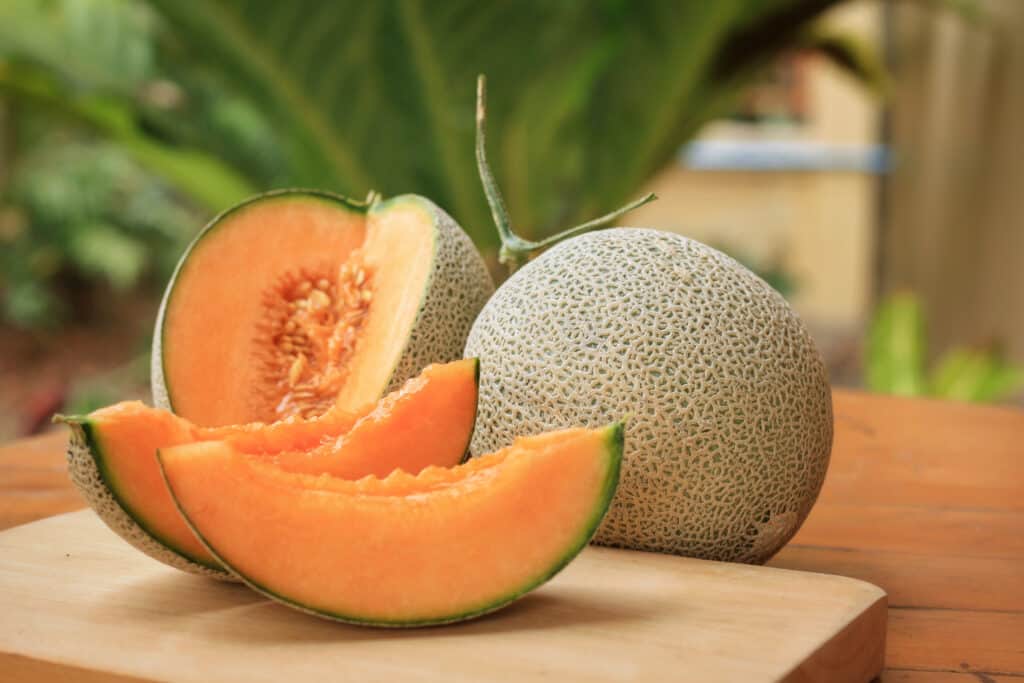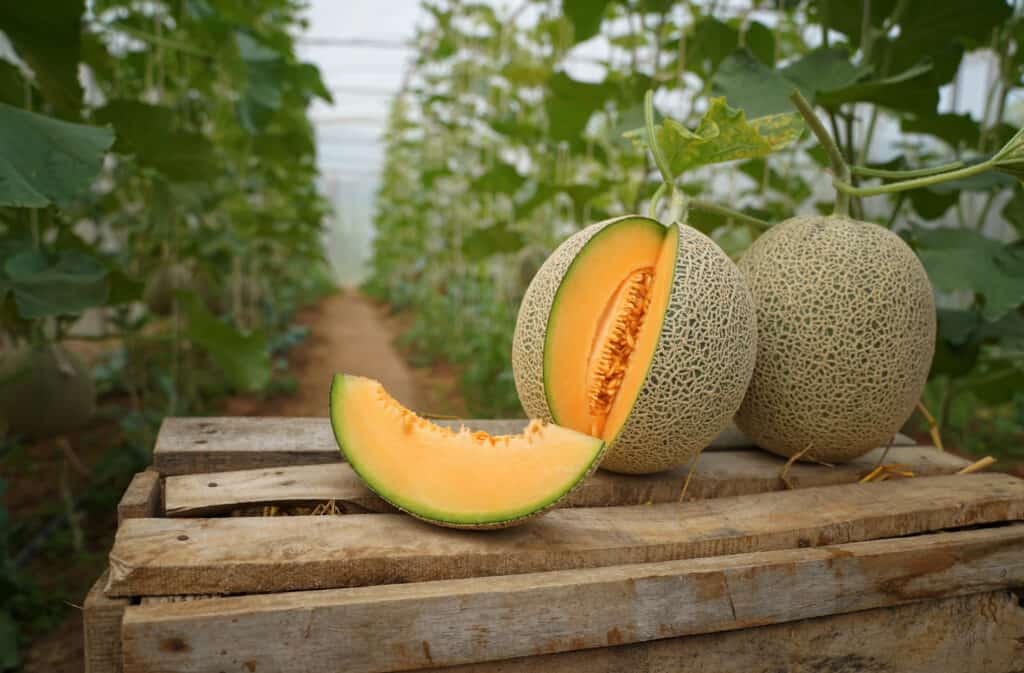If you’re not a melon or cantaloupe enthusiast, you might end up believing that the Athena melon is basically a cantaloupe, but with a couple of different aspects. That’s not the case, obviously, as the Athena melon can really make a difference in your garden, especially if you want to have a good dessert in July.
In the following lines, we’ll showcase the main differences between the muskmelon known as Athena Melon and the cantaloupe. Stay tuned if you want to know more!
What Is Athena Melon?

The Athena melon is often regarded as a medium-sized cantaloupe.
©Gurcharan Singh/Shutterstock.com
When talking about Athena melon, people usually refer to several types of melon. The Athena melon is often regarded as a medium-sized cantaloupe, as well as a cantaloupe hybrid or a muskmelon. The essential bit is that all of the mentioned terms essentially refer to the same plant – cantaloupe. Some sources list Athena melon under the scientific name of Cucumis melo var. reticulatus, which is a cultivar group of muskmelons.
In short, the Athena melon is a Cucumis melo (melon) variety known for its longer ripening period. It is currently one of the most common melons grown in gardens or for commercial purposes. This is because, due to the lengthened ripening period, specimens remain sweet and firm for a longer period without the risk of becoming soft.
This melon subtype, if you may, is also richer in sugar than the common cantaloupe. It is also larger than most cantaloupes – the Athena melon weighs, on average, about 5-7 lbs.
What Is Cantaloupe?

The cantaloupe is a melon variety that is part of the
Cucumis melospecies.
©iStock.com/Kwangmoozaa
The cantaloupe, often referred to as rockmelon, sweet melon, or spanspek, is a melon variety that is part of the Cucumis melo species. Its scientific name is C. melo subsp. melo, but it is better known in the industry by its cultivar group, Cantalupensis Group.
Is Athena Melon the Same as Cantaloupe?
No, Athena melon isn’t the same as cantaloupe. Cucumis is the genus that encompasses both the Athena melon and cantaloupe varieties. Both plants are part of the same species, Cucumis melo. The cultivar group is what helps tell them apart.
The Importance of Cultivar Groups When Comparing Plants
The Cantalupensis Group, known especially for including cantaloupe, incorporates the Reticulatus Group. The latter is known for including the Athena melon. For further explanation, a plant joins or is introduced into a cultivar group if it shares a defining characteristic with other group members.
The Key Differences Between Athena Melon vs. Cantaloupe
Now that we’ve gotten the botanical aspects out of the way, it’s time to move on to the specific differences between these two varieties of melons.
Athena Melon vs. Cantaloupe: Size, Shape, Weight, and Skin

The Athena melon is round and medium-sized.
©Route66/Shutterstock.com
The Athena melon is round and medium-sized. It weighs about 5-7 lbs – it’s not a large melon variety. Its exterior is characterized by a tough rind that presents coarse netting. The skin of the Athena melon can be pale orange or tan.
The cantaloupe is small to medium-sized. It weighs between 1 and 11 lbs – it is usually smaller than the Athena melon but can sometimes grow almost double in size. Unlike the Athena melon, the cantaloupe can have an oblong shape besides the common, round one. Cantaloupes include several types of melons, which is why they don’t have a specific general skin color. Their exterior is also netted but not as coarse as that of Athena melons.
Athena Melon vs. Cantaloupe: Ripening Season
The Athena melon is available throughout the summer, especially in July. This variety is predominantly grown in the eastern United States.
The cantaloupe is also available throughout the summer and is usually grown across both hemispheres. Unlike the Athena melon, the cantaloupe is predominantly grown in Asia and Europe, although it can be found pretty much throughout the entire world.
Athena Melon vs. Cantaloupe: Nutritional Values

Cantaloupe is rich in vitamin C, vitamin A, antioxidants, fiber, magnesium, potassium, vitamin B6, niacin, folate, and thiamine.
©Kotcha K/Shutterstock.com
The Athena melon is rich in beta-carotene, potassium, vitamin C, fiber, and folate. It is, in short, a vitamin bomb for the body. This is the main reason why the melon variety is extremely popular.
The cantaloupe is rich in vitamin C, vitamin A, antioxidants, fiber, magnesium, potassium, vitamin B6, niacin, folate, and thiamine. Its nutritional values are similar to that of the Athena melon; the major difference between the two is the taste and appearance.
Athena Melon vs. Cantaloupe: Taste
The Athena melon is often referred to as having incredible sweetness. Upon tasting a slice of this melon variety, you can expect a honey-like taste accompanied by a floral aroma. Compared to the cantaloupe, which has only 0.27 oz of sugar per 3.5 oz of product, the Athena melon’s sugar levels are around 0.38 oz per 3.5 o.z of fruit.
The cantaloupe’s taste is often described as tender, juicy, and sweet. Like the Athena melon, it is characterized by a sweet flavor but has a mushier texture, especially when it is ripe. The cantaloupe can sometimes be considered tasteless, mainly because the plant doesn’t get ripe until it is almost ready to pick. This is a fast process and the reason you might encounter cantaloupes without flavor in your grocery store.
Interesting Melon Facts
As mentioned, the melon family has quite a lot of species and variations in it. If you have the chance, you should try each type of melon at least once. Here are some interesting facts about this often juicy and sweet fruit.
- Watermelon is the most-consumed melon in the United States;
- While melons are generally considered fruits, the watermelon is both a vegetable and a fruit;
- Melons have been cultivated in Ancient Egypt since 2000 B.C;
- Melons were used as canteens by the early Spanish explorers who introduced them to America;
- Cantaloupes were developed much, much later than the initial melons. They appeared in Cantalup in the 1700s;
- Cantaloupes have a growing period of about 3-4 months. Once the growing period ends, they can quickly ripen;
- Unlike other types of melon, cantaloupes will stop ripening once picked;
- The most expensive melons in the world are grown in Japan and are known as Yubari King melons. A single specimen can cost as much as $10,000;
- Cucumbers and squash are very close relatives of melons, hence why some species are vegetables as well.
How to Pick Out a Good Cantaloupe

A ripe-for-eating cantaloupe will smell sweet.
©Attasit saentep/Shutterstock.com
It can be challenging to determine which melon will taste the best. A person can spend minutes scanning the outside, but the secret to picking the right melon is by smell and touch. A ripe cantaloupe should smell sweet and slightly musky. The optimum place to sniff a melon is at the round spot opposite of its stem. Next, press the spot opposite of the stem of the cantaloupe; it should be slightly soft, not super soft. A very firm cantaloupe means it is not ripe enough yet and shouldn’t be eaten. The outside should of be free of brown and soft spots. These bruises may be indicators of overly ripe, mushy melon.
The photo featured at the top of this post is ©
Sources
- Specialty Produce, Available here: https://specialtyproduce.com/produce/Athena_Melon_12327.php
- Specialty Produce, Available here: https://specialtyproduce.com/produce/Cantaloupe_Melon_788.php
- Melissa's, Available here: https://www.melissas.com/products/athena-melons
- Healthline, Available here: https://www.healthline.com/nutrition/muskmelon-vs-cantaloupe
Thank you for reading! Have some feedback for us? Contact the AZ Animals editorial team.






